
SKYWARN Nets
General Information Nets
Non-Monsoon Net (October 1 - June 14)
During Non-Monsoon Season the General Information Net Meets Every 3rd Wednesday, September 21 – June 14 at 1930 Hrs 7:30PM. or 0230 Hrs Zulu on the EAARS Repeaters.
Monsoon Net (June 15 - September 30)
Skywarn Net meets on Wednesday nights just after the Saguaro National Traffic System Net, June 15 – September 30 at 1930 Hrs. or 0230 Hrs Zulu, on the E.A.A.R.S. Eastern Arizona Amateur Radio Society , EAARS Repeaters, with an alternate frequency of 146.880 (-) offset, PL 110.9, this repeater is on Mt. Lemmon, during the Monsoon Season.
Activation Nets
Local Severe Weather Net
Local severe weather nets can be called by any trained Skywarn spotter who has completed the Net Control Operator training any time the weather becomes sufficiently severe to warrant an orderly communication of weather-related hazards, injuries or damage. Local Activation does not take the place of calling 911 to report serious injuries or damage that poses a threat to life and limb.
See the Local Severe Weather net criteria page for more information on activating a severe weather net.
Full Skywarn Sector 1 Activation Net
There are between three and six days during the average monsoon season that bring severe regional weather to Southern AZ. These days, when identified warrant the activation of the full Skywarn Net. What makes these days different is their potential for the development of supercell thunderstorms with its implicit dangerous hail and even tornados. Or they can be large regional systems that while not classified as supercells, still bring wide scale severe weather with the hazards, injuries and damage that accompanies them. Luckily, these are wide area events for which we will usually have advanced warning, and for which we can plan with the NWS forecast center. For these events a trained Net Control Operator will, after consultation with the NWS warning desk activate the Full Skywarn Sector 1 net on the EAARS Repeater System.
EAARS System Linked Repeaters
146.86 and (440.700 Hub) Heliograph Peak
147.28 Guthrie Peak - Greenlee County
145.21 Jacks Peak New Mexico. Between Lordsburg & Silver City
145.41 Pinal Peak Near Globe AZ
147.16 Mt Lemmon Near Tucson
146.70 Greens Peak Near Springerville - Showlow
145.27 South Mtn. Near Alpine, AZ
147.08 Mule Mtn. Near Bisbee in Cochise County
147.06 Lil Florida Mtn. Near Deming, New Mexico
145.47 Caballo Mtn. Near Truth or Consequences, New Mexico
145.35 West Peak. West of Heliograph 12 miles
All EAARS network repeaters operate with PL tone 141.3
General Information Nets
Non-Monsoon Net (October 1 - June 14)
During Non-Monsoon Season the General Information Net Meets Every 3rd Wednesday, September 21 – June 14 at 1930 Hrs 7:30PM. or 0230 Hrs Zulu on the EAARS Repeaters.
Monsoon Net (June 15 - September 30)
Skywarn Net meets on Wednesday nights just after the Saguaro National Traffic System Net, June 15 – September 30 at 1930 Hrs. or 0230 Hrs Zulu, on the E.A.A.R.S. Eastern Arizona Amateur Radio Society , EAARS Repeaters, with an alternate frequency of 146.880 (-) offset, PL 110.9, this repeater is on Mt. Lemmon, during the Monsoon Season.
Activation Nets
Local Severe Weather Net
Local severe weather nets can be called by any trained Skywarn spotter who has completed the Net Control Operator training any time the weather becomes sufficiently severe to warrant an orderly communication of weather-related hazards, injuries or damage. Local Activation does not take the place of calling 911 to report serious injuries or damage that poses a threat to life and limb.
See the Local Severe Weather net criteria page for more information on activating a severe weather net.
Full Skywarn Sector 1 Activation Net
There are between three and six days during the average monsoon season that bring severe regional weather to Southern AZ. These days, when identified warrant the activation of the full Skywarn Net. What makes these days different is their potential for the development of supercell thunderstorms with its implicit dangerous hail and even tornados. Or they can be large regional systems that while not classified as supercells, still bring wide scale severe weather with the hazards, injuries and damage that accompanies them. Luckily, these are wide area events for which we will usually have advanced warning, and for which we can plan with the NWS forecast center. For these events a trained Net Control Operator will, after consultation with the NWS warning desk activate the Full Skywarn Sector 1 net on the EAARS Repeater System.
EAARS System Linked Repeaters
146.86 and (440.700 Hub) Heliograph Peak
147.28 Guthrie Peak - Greenlee County
145.21 Jacks Peak New Mexico. Between Lordsburg & Silver City
145.41 Pinal Peak Near Globe AZ
147.16 Mt Lemmon Near Tucson
146.70 Greens Peak Near Springerville - Showlow
145.27 South Mtn. Near Alpine, AZ
147.08 Mule Mtn. Near Bisbee in Cochise County
147.06 Lil Florida Mtn. Near Deming, New Mexico
145.47 Caballo Mtn. Near Truth or Consequences, New Mexico
145.35 West Peak. West of Heliograph 12 miles
All EAARS network repeaters operate with PL tone 141.3

